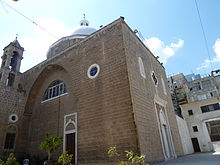Maronites in Israel
الموارنة في إسرائيل | |
|---|---|
| Total population | |
| 11,000 | |
| Religion | |
| Christianity (Maronite Church) | |
| Related ethnic groups | |
| Arameans in Israel, Assyrians in Israel |
Since 2014, Maronites in Israel are eligible to register their ethnicity as "Aramean".
History

The Maronite community in
The Maronite population of Israel has significantly
Maronite Church in Israel and Palestine

The
The Maronites in
According to the 2022 Annuario Pontificio, in 2021 the Maronite Catholic Archeparchy of Haifa and the Holy Land had 10,000 members, 6 parishes, 11 priests and 1 deacon. In 2020, the Maronite Catholic Patriarchal Exarchate of Jerusalem and Palestine had 504 members, 3 parishes, 1 priest and 1 deacon.[14]
Identity
Maronite Aramean identity
A study on Maronites' identity in Israel performed at Haifa University found that most of this community rejected Arab identity in favor of a distinct Maronite identity,[8] and that many Maronite residents of Jish considered themselves Aramean Christian Maronites.[15]
In 2014, Israel decided to recognize the Aramean community within its borders as a national minority, allowing some of the Christians in Israel to be registered as "Aramean",[16] instead of "Arab" or "Unclassified". The Christians, who may apply for recognition as Aramean, are mostly Galilean Maronites, who trace part of their cultural identity to the Arameans.[17]
Language
Traditionally, Neo-Aramaic had been the spoken language of the Maronites up to the 17th century, when Arabic took its place, while Classical Syriac remained in use only for liturgical purposes. In 2011, activists tried to revitalize Syriac by teaching it for young children in Jish Elementary School, with approval of the Israeli Ministry of Education. The program was implemented briefly by the school, but was quickly dropped.[18][15]
See also
| Part of a series on the |
| Maronite Church |
|---|
 |
| Patriarchate |
|
| Religious orders and societies |
|
| Communities |
|
| Languages |
| History |
| Related politics |
|
|
- Arameans in Israel
- Assyrians in Israel
- Christianity in Israel
- Lebanese in Israel
References
- ^ "Cardinal is first top Lebanese cleric in Israel". Associated Press. 26 May 2014.
- ^ https://books.google.de/books?id=XOvGEAAAQBAJ&pg=PA68&dq=icaa+aramean&hl=de&newbks=1&newbks_redir=0&source=gb_mobile_search&sa=X&ved=2ahUKEwiG3f6wmfmCAxVx3QIHHSVjDHEQ6AF6BAgOEAM#v=onepage&q=icaa%20aramean&f=false, "In 2014, Khalloul founded the Israeli Christian Aramaic Association (ICAA), which primarily aims to revitalize and preserve Aramaic Syriac as a language …"
- ^ ISBN 9781900949903. Retrieved 2012-11-26.
- ^ Morris, 2004, p. 508
- ^ "The Aramaic language is being resurrected in Israel". Vatican Insider - La Stampa. 24 September 2011. Archived from the original on 6 March 2016.
More than half of its current 3,000 inhabitants are Maronite Christians, whom Israeli soldiers displaced from neighboring Bir'am in 1948; they were not allowed to return to their village of origin, which became the Bar'am Kibbutz.
- ^ "Maronite Catholic Church". Jcjcr.org. Archived from the original on 2013-05-03. Retrieved 2012-11-26.
- ^ "Faith | the Times". Archived from the original on 5 May 2013.
- ^ a b c "Haifa thesis" (PDF). Archived from the original (PDF) on September 30, 2011. Retrieved October 9, 2011.
- ^ Hugi, Jacky (15 March 2013). "Aramaic Language Project in Israel Furthers Recognition of Maronites". al-monitor.com. Al-Monitor, LLC.
More than 10 thousand Maronites are currently living in Israel. Two thousand of them are former South Lebanon Army (SLA) combatants and their family members who moved to Israel following the withdrawal of the Israel Defense Forces (IDF) from Lebanon in 2000.
- ^ "The Christian communities in Israel". mfa.gov.il.
- ^ "These Young Israelis Were Born in Lebanon – but Don't Call Them Arabs". Haaretz. Retrieved 2021-10-15.
- ^ S2CID 211647029.
- ^ History of the Maronites of the Holy Land: in French and in English
- ^ "Current Maronite Dioceses". Catholic Hierarchy. David M. Cheney. 2023.
- ^ a b "Aramaic Maronite Center". Aramaic-center.com. Archived from the original on 2016-07-01. Retrieved 2012-11-26.
- ^ "Ministry of Interior to Admit Arameans to National Population Registry". 16 September 2014.
- ^ "Israel Hayom". www.israelhayom.com. Retrieved 2020-06-21.
- ^ ""We Want To Speak The Language That Jesus Spoke": The Revival Of Aramaic in Jish, Israel « News « Articles « OneIsrael.org . . . israelstreet.org". israelstreet.org. Retrieved 2022-11-07.
